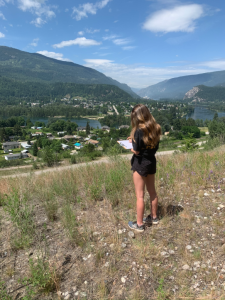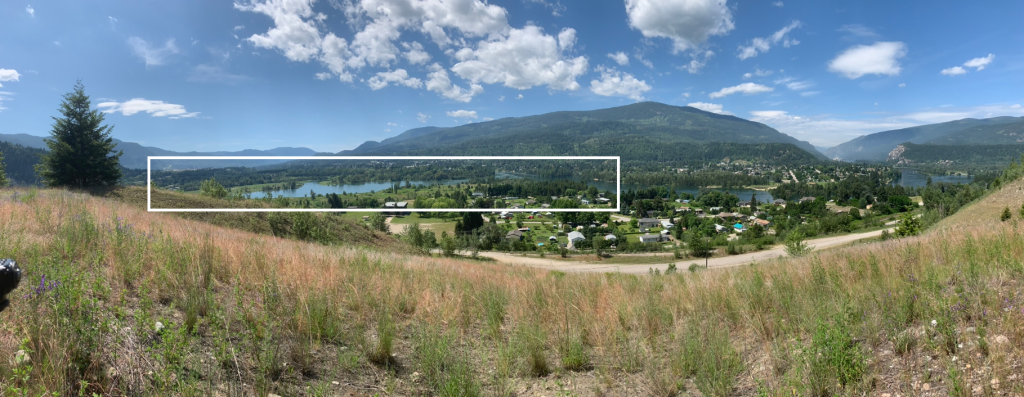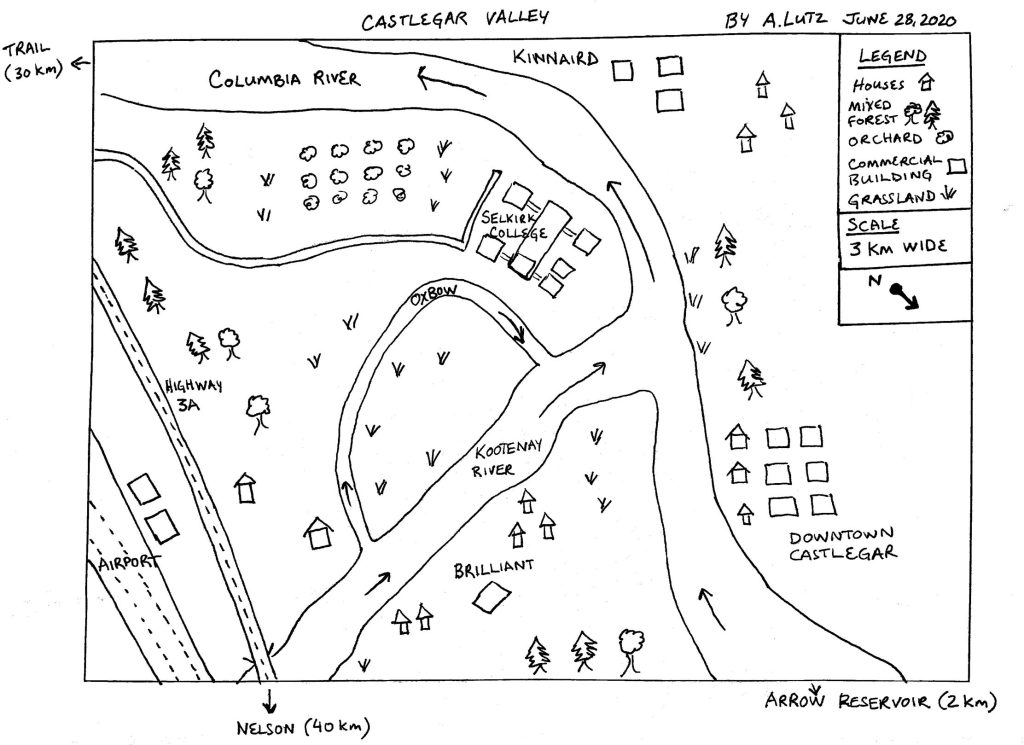Lab 01: Earth Systems and Earth’s Four Spheres
Allison Lutz
Making observations of the landscape is an essential component of geography. This lab will connect you with the geography of the place in which you live. It is an important skill to describe the natural and anthropogenic features of the landscape, and to consider ways in which a change in one aspect may affect all others. It is only as we seek to understand the interconnectedness of Earth spheres and systems that we will find appropriate solutions to our global environmental issues.
Learning Objectives
After completion of this lab, you will be able to
- Orient a map to the landscape.
- Draw a simple sketch map.
- Name and identify natural and built features of the local area.
- Observe and record characteristics of the local atmosphere, lithosphere, hydrosphere, and biosphere.
- Describe the anthropogenic impacts on natural systems.
- Examine examples of positive and negative feedback systems at work.
- Describe potential changes to natural systems.
Pre-Readings
To complete this lab, you will need background information on geographic approaches and themes, drawing sketch maps, Earth spheres, and systems theory. A brief summary is provided here. These topics are typically covered in Chapter One of first-year geography textbooks. Use the textbook’s index to find these topics, then read about them if you require more detailed information.
Geographic Approaches and Themes
Textbooks may vary on the exact terms used to describe geographic approaches and themes. Central to the study of physical geography is the approach of a spatial analysis, and the concept that there is a natural world that is impacted by human activities. Humans are in turn influenced by natural systems. Monitoring, striving to understand, and mitigating environmental change is a key aspect of physical geography
Earth Spheres
Our natural environment can be broken down into four spheres. Keep in mind, however, that these sub-divisions are artificial and that in reality there is constant and considerable interaction and overlap between all spheres.
The hydrosphere consists of water in all its forms (solid, liquid, and gas; fresh and salty), as it appears at or near the Earth’s surface. It includes oceans, rivers, lakes, springs, glaciers and ice caps, shallow groundwater, and atmospheric water vapor.
The atmosphere is a mixture of gases, forming an envelope around the Earth, and held in place by gravity. Up to an altitude of about 80 km the composition is nearly constant at 21% oxygen, 78% nitrogen, and traces of argon, xenon and krypton. In addition, there are variable quantities of carbon dioxide, methane, and water. We are most interested in the troposphere, the lower 18 km where weather and climate are determined.
The lithosphere is the upper mantle and the Earth’s crust that create landscape features such as mountains and valleys.
The biosphere includes all living things and their physical environment. It extends from several kilometers below the sea floor to about 8 km above the surface and requires the presence of water as well as an energy source of some kind. The range for individual species within the biosphere can change as local conditions within the other spheres change (Christopherson, R.W. & Byrne M.L., 2015).
Systems Theory and Feedback Loops
A system is any ordered, interrelated set of things and their attributes, linked by flows of energy and matter. A system is in some way distinct from its surrounding environment; for example, a watershed is an identifiable system. Systems are described as open if they are receiving inputs and providing outputs of matter and energy. A system is described as closed if it receives inputs and outputs of energy but not matter. Very few systems are truly closed
If a system is at steady state, it will fluctuate around conditions which are considered normal for that system. This is known as dynamic equilibrium. Feedback loops govern the response of a system to change. Feedback loops may be either negative (maintain equilibrium), or positive (lead to a new equilibrium). For example, consider seasonal variability in water level in a stream. Normally, the water level is low enough to wade across. During snow melt, the water level will increase because of the extra water being added from the melting snow, but the water levels will drop again once that snow has disappeared, and temperatures rise. This correction or return to normal conditions is a negative feedback loop. If a system moves out of its steady state, or out of equilibrium and a system continues in that direction then the system is said to be in a positive feedback loop. Many global changes that are occurring as a result of climate change, such as the melting of polar icecaps, are in positive feedback loops. Eventually the system will find a new equilibrium.
Lab Exercises
In this introductory geography lab you will become familiar with the local geography and begin to think like a geographer.
This lab includes three exercises that result in creating an assignment to be handed in as a report in PDF format. The submitted report will include a series of figures with captions. The entire lab will take approximately 2 hours to complete.
Exercise 1 is mostly field-based, whereas Exercises 2 and 3 are office-based. You will need to allow for travel time (walking, biking, public transit, driving etc.) to your field site for Exercise 1. The field sketch (see Worksheets for a blank sketch map template) should take approximately half an hour to complete. The rest of the lab will take the remaining time.
Contact your instructor for an alternative approach to these exercises if you are experiencing mobility or visual constraints.
Required materials:
- Camera (cell phone is fine).
- Pencil, clipboard, and some blank pieces of paper to sketch on.
Required software:
- Google Maps
- Word processing software (Word, Google Docs)
EX1: Field Sketch
Step 1: Select Your Location
Start by opening Google Maps on your phone or computer. Zoom into the area you will be viewing in the field. If you are on a desktop computer you will need to print the map, otherwise refer to the map on your phone or tablet while in the field. It will be helpful to watch Video 1.1:
Video 1.1. Orienting a map to the landscape
Identify a safe and easily accessible place where you can view the landscape from above, and make and record your observations. Examples of viewpoints (also known as overlooks) include a hillside, bridge, or tall building – your instructor can suggest locations. When you go to the field you will need to bring
- camera (cell phone is fine)
- clipboard, some blank pieces of paper, and a pencil, and
- a digital or printed copy of the lab exercises.
Ahead of your departure read through the Lab Exercises.
Safety: Do not complete the remainder of this exercise until receiving a safety briefing and filling the proper paperwork (if applicable) from your lab instructor. In addition, your first goal when you arrive at a site is to ascertain whether the terrain is safe.
Step 2: Orient Your Map

Once you have arrived at your chosen viewpoint you will need to orient your map to your location. Open the map on your phone or tablet or pull out the paper copy of the map.
- Find your location on the map. If you are on Google Maps this is easily done by pressing the small arrow. Zoom in or out to view the map at a scale that reflects what you can see in the landscape.
- Find features on the map that are evident in the surrounding terrain.
- Turn your map (phone) so that the features in front of your view match the features on your map.
- Assuming north is at the top of your map, determine where north is relative to the direction you are facing.
Step 3: Frame Your Field Sketch (Figure EX1.1)
You may be new to this area of British Columbia or you may have lived here your entire life; regardless, you can build your geographic literacy by being able to name and describe the natural and built features of the surrounding landscape.
Find a suitable viewpoint and spend a few moments observing the landscape (see Figure 1.1).
Decide on an area that is appropriate to capture in your sketch. It may be a valley bottom with a river running through it or you could narrow in on a smaller area such as your neighbourhood. The sketch will be from above, a bird’s eye view or map view.
Photograph the landscape from your position. With annotation, this photograph will become Figure EX1.1 in your lab report (see example Figure 1.2).

Step 4: Create Your Field Sketch (Figure EX1.2)
Sketch a map of the area you identified. You do not need to be an artist to complete a field sketch. The best maps are simple with clearly defined lines. A sheet is provided for your sketch in Worksheets (Blank Sketch Map).
The following are important elements to consider as you draw your map. Refer to Figure 1.3 for a sample sketch map.
- Clearly define the boundaries or edges of your map. Mountains, watersheds, shorelines, roads and railways tend to define our vision and are commonly used as edges. The scale of a sketch is determined by the objects in view and the amount of detail required to be shown. Determine how much area you want to draw. From the viewpoint, the area in the rectangle on Figure 1.2 was selected for the sketch map.
- Identify pathways or routes which dissect your selected area such as roads, trails, rivers, streams, power lines. We generally experience our surroundings as we move along these routes. Show direction of travel of rivers with an arrow.
- Identify any significant junction points where important pathways come together. The confluence (meeting) of two streams, the intersection of two roads.
- Identify polygons or districts. These are small areas with a common feature, such as urban areas, single family housing, parks, open fields, changes in vegetation type (from leaf bearing/deciduous to needle bearing/coniferous) etc.
- Identify any significant landmarks that are distinctive because of their height, shape, or historical significance. An example might be a well-known mountain peak, a waterfall, a statue, a mall. (Lynch,1960)
- On your map you must also include
- title/location,
- date,
- your name,
- legend (symbols which indicate vegetation type, mountains, urban areas),
- north arrow, and
- approximate scale. Relate the scale to a dimension of your sketch map, as done on Figure 1.3.

Photograph your sketch map before leaving the field.
Step 5: Document Your Field Work (Figure EX1.3)
Take a selfie (photograph of yourself) at the field site holding your field sketch.
Step 6: Create the EX1 Portion of Your Lab Report
Once you are back home, open a Word document on your computer, and create a title page for your lab report that includes the title of this lab assignment, your name, lab section, and date.
Create the EX1 portion of your lab report by inserting the title Exercise 1: Field Sketch and insert the figures you created in the field:
- Figure EX1.1: Frame of your field sketch. Insert the photo as a picture, and add a rectangle to indicate the boundary of your field sketch.
- Figure EX1.2: Field sketch. Insert the photo of your field sketch.
- Figure EX1.3: Documentation of field work. Insert your selfie.
Add descriptive captions to each figure to complete this portion of the report.
EX2: Earth Spheres
Create a new section of your lab report titled Exercise 2: Earth Spheres. Copy Table 1.1 below and paste into your lab report. The table is also available in Worksheets (Lab 01 Table 1.1).
Using the map, local knowledge, and if needed, a computer search, identify local characteristics of the hydrosphere, atmosphere, lithosphere and biosphere, and anthropogenic impacts. Complete the table with
- Landscape features: identify two to four features for each sphere. Describe each feature with, for example, size, location and significance; and
- Anthropogenic impacts: describe ways in which the sphere has been altered by humans. Be specific.
Your answers may pertain to the area in general and need not be restricted to the area represented by your field map.
*Coniferous tree is a needleleaf tree that bears cones
**Deciduous tree is a leaf-bearing tree that sheds its leaves seasonally
EX3: Systemic Change
We are living through an era of rapid environmental change. Consider ways in which a change in one sphere may affect all others in your area. Point form is acceptable.
- Specific to the landscape you are observing, describe how a catastrophic (very large) wildfire might impact each sphere. Consider both the immediate impacts and long-term impacts. List 4-7 impacts.
- Identify one specific change created by the wildfire and discuss whether it is a positive or negative feedback loop. Describe in 2-3 sentences.
- Depending on whether hydrological dams exist in your area, consider how either putting in a dam or removing dams (if they already exist) might impact local spheres and alter the entire watershed system. List 4-7 impacts.
- Describe how a pandemic lockdown has impacted human activities and how it may have altered each of Earth’s spheres in your area or on a global scale. Provide two examples of how it has altered. Limit your answer to 4-8 sentences.
Create a new section of your lab report titled Exercise 3: Systemic Change and type in your answers.
Reflection Questions
- Now that you have completed a field sketch, describe how this process differs from simply printing a map or taking a photograph. (1-2 sentences)
- What information could be conveyed on a field sketch that is not available on photographs, remotely sensed images or a map? (3 sentences)
- Describe the sense of place this area has for you; this will be different for each student depending on your life experiences. For example, are you connected to this landscape? Are you concerned or optimistic about how the landscape is changing? Try to be honest here, do not write what you think your instructor is looking for. (3-5 sentences)
Create a new section of your lab report titled Reflection Questions and type in your answers.
Report Submission
Once all exercises are complete, save the assignment as a PDF and submit as directed by your instructor.
Worksheets
Blank Sketch Map
EX2 Table 1.1
References
Christopherson, R.W. & Byrne M.L. (2015). Geosystems: An introduction to physical geography (Canadian 4th ed.). Prentice-Hall Inc.
Lynch, K. (1960). The image of the city. MIT Press.
Media Attributions
- Video 1.1: Orienting a map to the landscape video by Trail magazine is licensed under a Standard YouTube License.
- Figure 1.1: Image by A. Lutz is licensed under a CC BY-NC-SA 4.0 licence.
- Figure 1.2: Image by A. Lutz is licensed under a CC BY-NC-SA 4.0 licence.
- Figure 1.3: Image by A. Lutz is licensed under a CC BY-NC-SA 4.0 licence.

